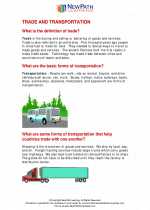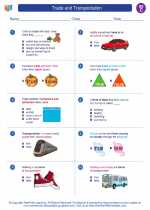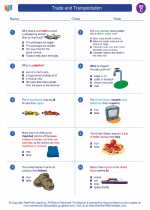Climate
Climate refers to the typical or average weather conditions that a region experiences over a long period of time, usually 30 years or more. It is determined by factors such as temperature, humidity, precipitation, and wind patterns. Climate greatly influences the types of vegetation, animal life, and human activities in a particular area.
Factors Affecting Climate
- Latitude: The distance from the equator affects the amount of sunlight an area receives, which in turn impacts temperature and climate.
- Altitude: Higher elevations generally have cooler temperatures due to decreased air pressure and lower levels of heat retention.
- Distance from the sea: Coastal areas tend to have milder climates due to the moderating effects of the ocean.
- Ocean currents: Currents can bring warm or cold water to coastal areas, influencing the temperature and climate of nearby regions.
- Wind patterns: Prevailing winds can carry moisture and affect temperature, leading to different climate patterns.
Types of Climate
There are several major climate types, including:
- Tropical: Characterized by high temperatures and heavy rainfall, typically found near the equator.
- Temperate: Moderate temperatures and distinct seasons, common in regions away from the equator.
- Desert: Hot and dry with very low precipitation, often found in arid regions.
- Polar: Extremely cold temperatures with little precipitation, typical of polar regions.
- Continental: Varying temperatures and distinct seasons, often experienced in the interior of large landmasses.
- Mountainous: Varied climate based on altitude, with temperature and precipitation changing as elevation increases.
Climate Change
Climate change refers to long-term shifts in temperature, precipitation, and other climate patterns. Human activities, such as the burning of fossil fuels and deforestation, have contributed to changes in the Earth's climate, leading to global warming and its associated effects.
Study Guide
- What factors determine climate?
- Describe the major types of climate.
- How do human activities contribute to climate change?
- Explain the impact of climate on vegetation and animal life.
- Discuss the differences between weather and climate.
[Climate] Related Worksheets and Study Guides:
.◂Social Studies Worksheets and Study Guides Third Grade. Trade and Transportation
Study Guide Trade and Transportation
Trade and Transportation  Worksheet/Answer key
Worksheet/Answer key Trade and Transportation
Trade and Transportation  Worksheet/Answer key
Worksheet/Answer key Trade and Transportation
Trade and Transportation  Worksheet/Answer key
Worksheet/Answer key Trade and Transportation
Trade and Transportation 

 Worksheet/Answer key
Worksheet/Answer key
 Worksheet/Answer key
Worksheet/Answer key
 Worksheet/Answer key
Worksheet/Answer key

The resources above cover the following skills:
National Curriculum Standards for Social Studies (NCSS)
PRODUCTION, DISTRIBUTION, AND CONSUMPTION
SOCIAL STUDIES PROGRAMS SHOULD INCLUDE EXPERIENCES THAT PROVIDE FOR THE STUDY OF HOW PEOPLE ORGANIZE FOR THE PRODUCTION, DISTRIBUTION, AND CONSUMPTION OF GOODS AND SERVICES.
KNOWLEDGE - Learners will understand:
The goods and services produced in the market and those produced by the government.
SCIENCE, TECHNOLOGY, AND SOCIETY
SOCIAL STUDIES PROGRAMS SHOULD INCLUDE EXPERIENCES THAT PROVIDE FOR THE STUDY OF RELATIONSHIPS AMONG SCIENCE, TECHNOLOGY, AND SOCIETY.
KNOWLEDGE - Learners will understand:
That science often leads to new technology in areas such as communication and transportation, and results in change over time.
National Standards for Civics and Government (NSCG)
What is the Relationship of the United States to Other Nations and to World Affairs? How do nations interact with one another?
Interaction among nations: Students should be able to explain the major ways nations interact with one another. To achieve this standard, students should be able to
Explain how nations interact through
Trade, e.g., buying and selling manufactured and agricultural goods such as airplanes, farm equipment, clothing, food
National Content Standards in Economics (NCSE)
Scarcity
Students will understand that productive resources are limited. Therefore, people cannot have all the goods and services they want; as a result, they must choose some things and give up others. Students will be able to use this knowledge to identify what they gain and what they give up when they make choices.
At the completion of Grade 4, students will know that:
Most people produce and consume. As producers they help make goods and services; as consumers they use goods and services to satisfy their wants.
At the completion of Grade 4, students will use this knowledge to:
Identify people who are consumers and provide examples in which students were consumers of goods and services. Identify people who are producers and provide examples of situations in which students helped produce goods and services.
Allocation
Students will understand that different methods can be used to allocate goods and services. People acting individually or collectively must choose which methods to use to allocate different kinds of goods and services. Students will be able to use this knowledge to evaluate different methods of allocating goods and services, by comparing the benefits to the costs of each method.
At the completion of Grade 4, students will know that:
No method of distributing goods and services can satisfy all wants.
Students will understand that different methods can be used to allocate goods and services. People acting individually or collectively must choose which methods to use to allocate different kinds of goods and services. Students will be able to use this knowledge to evaluate different methods of allocating goods and services, by comparing the benefits to the costs of each method
At the completion of Grade 4, students will know that:
There are different ways to distribute goods and services (by prices, command, majority rule, contests, force, first-come/first-served, sharing equally, lottery, personal characteristics, and others), and there are advantages and disadvantages to each.
Trade
Students will understand that voluntary exchange occurs only when all participating parties expect to gain. This is true for trade among individuals or organizations within a nation, and among individuals or organizations in different nations. Students will be able to use this knowledge to negotiate exchanges and identify the gains to themselves and others. Compare the benefits and costs of policies that alter trade barriers between nations, such as tariffs and quotas.
At the completion of Grade 4, students will know that:
Exchange is trading goods and services with people for other goods and services (called barter) or for money.
The oldest form of exchange is barter, the direct trading of goods and services between people.
At the completion of Grade 4, students will use this knowledge to:
Identify exchanges they have made and tell whether they were monetary or barter exchanges.
Identify current and historical examples of barter exchanges.
Money and Inflation
Students will understand that money makes it easier to trade, borrow, save, invest, and compare the value of goods and services. The amount of money in the economy affects the overall price level. Inflation is an increase in the overall price level that reduces the value of money. Students will be able to use this knowledge to explain how their lives would be more difficult in a world with no money, or in a world where money sharply lost its value.
At the completion of Grade 4, students will know that:
Money (currency, coins, or checks) makes trading easier by replacing barter.
At the completion of Grade 4, students will know that:
People consume goods and services, not money; money is useful primarily because it can be used to buy goods and services.
Producers use natural resources, human resources, and capital goods (not money) to make goods and services.
At the completion of Grade 4, students will use this knowledge to:
Identify things that have been used as money at different times and in different societies and countries. Explain why some things can be used effectively for money and some things cannot.
National Center for History in Schools (NCHS)
Topic 4: The History of Peoples of Many Cultures Around the World
Major discoveries in science and technology, their social and economic effects, and the scientists and inventors responsible for them.
The student understands changes in transportation and their effects.